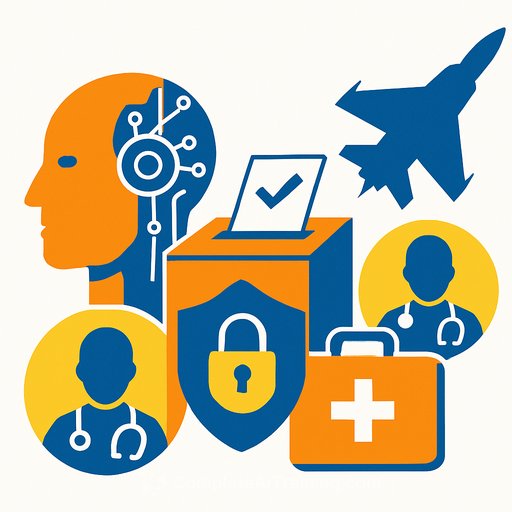AI risks to elections, healthcare, and national security - and how to reduce them
AI sits in more workflows than most teams realize. It accelerates drug discovery, enables personalized medicine, and speeds up analysis. But the same tools can amplify misinformation, expose clinical operations, and create market shocks that ripple into claims and underwriting.
AI systems are complex and adaptive. They learn from data, change over time, and can be pushed off course by biased inputs or malicious prompts. Because AI tools are widely available, the barrier to causing harm is low.
Election interference and financial volatility
Generative models make it easy to spin up fake accounts, fabricate convincing content, and target specific groups with precision. We have already seen elections disrupted by foreign interference through social platforms, with public trust taking the hit.
Markets are exposed too. An AI-generated image of an explosion near the Pentagon in 2023 briefly moved stock prices after the bell. Adversarial inputs can also skew AI-driven credit scoring, leading to approvals that increase portfolio risk.
Healthcare threats: bias, safety, and cyber exposure
During COVID-19, misinformation spread faster than corrections, undermining vaccine uptake and public health measures. That dynamic scales with generative tools that automate content creation and distribution.
Biased training data can lead to discriminatory recommendations. A Cedars-Sinai study found several large language models suggested inferior psychiatric treatments when a patient was indicated as African American. Hospitals and payers also face an expanded attack surface as AI becomes embedded in care delivery, revenue cycle, and member services.
National security and systemic risk
AI-enabled drones, grid disruptions, and influence operations have featured in modern conflict. These risks don't stay on the battlefield-critical infrastructure, health systems, and insurers absorb downstream shocks.
There is a geopolitical and environmental dimension as well: concentration of AI capability among a few actors, and the energy usage of large models. Both increase systemic exposure that boards and regulators now track closely.
What healthcare and insurance leaders can do now
For clinicians, risk managers, and analysts
- Use AI providers that meet security standards, comply with healthcare and privacy regulations, and publish model documentation and update cycles.
- Verify clinical or financial outputs before acting on them. Ask for sources, scrutinize unusual claims, and report errors or harmful content.
- Protect sensitive data: avoid pasting PHI/PII into public tools, control export settings, and use approved enterprise instances.
- Watch for manipulation: spoofed images, synthetic voices, and fabricated citations. Cross-check with authoritative sources.
For healthcare organizations and insurers
- Stand up AI governance: inventory models, assign ownership, define acceptable use, and align with risk tiers (e.g., clinical decision support, underwriting, claims fraud, member chatbots).
- Build model risk management: validation, drift monitoring, audit trails, challenger models, and clear escalation paths for high-stakes decisions.
- Harden against adversarial attacks: input sanitization, anomaly detection, content filters, prompt injection defenses, and human-in-the-loop for critical outcomes.
- Target bias reduction: curate representative datasets, run fairness tests by subgroup, apply mitigation techniques, and review impact with clinical and compliance leads.
- Secure the pipeline: least-privilege access, encrypted model artifacts, dependency scanning, and red team exercises covering data poisoning and model exfiltration.
- Design safe failure modes: fallbacks to traditional workflows, clear uncertainty handling, kill switches, and real-time monitoring of model confidence.
Cyber, incident response, and insurance coverage
- Update incident response playbooks for AI-specific threats (prompt injection, model misuse, synthetic identity fraud). Run tabletops with clinical ops, claims, and PR.
- Expand telemetry: log prompts, outputs, and model versions; monitor for drift and abuse patterns across user segments.
- Review and refine insurance programs: confirm cyber policies address AI-driven losses and consider AI-specific coverage for model failure, algorithmic bias claims, and business interruption.
Policy, compliance, and collaboration
- Track emerging regulation and implement by design. The EU AI Act takes a risk-based approach to development and deployment; use it as a blueprint for controls and documentation. EU AI Act overview
- Share lessons from incidents and near-misses to raise the floor across the sector. The AI Incident Database is a useful reference for patterns and controls.
Implementation checklist
- Define use cases with clear risk tiers and decision boundaries.
- Select enterprise-grade providers with healthcare and insurance compliance addenda.
- Set up model validation, bias testing, and periodic re-approval.
- Instrument monitoring, logs, and a feedback channel for clinicians, claims handlers, and customers.
- Run red team simulations and fix findings before scale-up.
- Align coverage with AI failure scenarios and third-party dependencies.
Upskill your teams
Skills reduce risk. Train clinicians, actuaries, underwriters, and claims teams on safe prompting, data privacy, model limits, and evaluation. Practical training accelerates adoption without compromising safety.
Explore role-based programs here: Complete AI Training - Courses by Job
AI will keep advancing. With clear governance, defensible controls, and a learning culture, healthcare providers and insurers can capture the benefits while keeping patients, members, and markets safe.
Your membership also unlocks:










